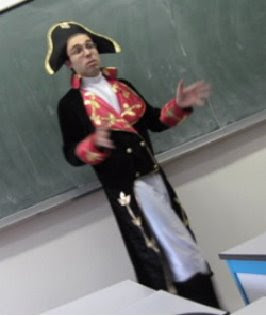 Trying to remember the exact moment I decided I wanted to go back to France produces a blur of memories: my return to college, Christmas dinner, whenever I wrote, read, or spoke French. But, I’d like to think that I made that decision the moment I stepped off the plane. What motivated me to make that decision was a growing desire to learn more. I felt that, during my three months studying in Rennes as an undergraduate, I had only seen a glimpse of the world that France had to offer. By the time my French reached a level where I comfortably express myself for extended periods of time, there was only one month left before I had to return to the United States.So, in the months that followed my return, I asked my professors what programs could provide me the opportunity to return to France and discover what I had tantalizingly seen just beyond that horizon. Their answer was unanimous; the Fulbright U.S. Student Program.
Trying to remember the exact moment I decided I wanted to go back to France produces a blur of memories: my return to college, Christmas dinner, whenever I wrote, read, or spoke French. But, I’d like to think that I made that decision the moment I stepped off the plane. What motivated me to make that decision was a growing desire to learn more. I felt that, during my three months studying in Rennes as an undergraduate, I had only seen a glimpse of the world that France had to offer. By the time my French reached a level where I comfortably express myself for extended periods of time, there was only one month left before I had to return to the United States.So, in the months that followed my return, I asked my professors what programs could provide me the opportunity to return to France and discover what I had tantalizingly seen just beyond that horizon. Their answer was unanimous; the Fulbright U.S. Student Program.
At first, I was encouraged to apply for a Fulbright Full Research or Study grant to France. My professors pushed me to develop a project over the summer and submit a proposal that following fall. Although I appreciated their advice and took it to heart, there was something that held me back. This reluctance was likely born out of my need for independence, a stubborn insistence that I make my own path. As I did my research on the various programs that the Fulbright U. S. Student Program offered, I noticed that France offered Fulbright English Teaching Assistantships for Americans with B.A. degrees or equivalent to teach in French high schools. Being an aspiring professor of European history, the chance to teach in France seemed too good of an opportunity to pass by. Now, I had a goal and a path to get me there.
The application process for the Fulbright U.S. Student Program was labor intensive but, nevertheless, a labor of love. I began the application process early that September and soon discovered that it was an art, not a science. Many applicants, I believe, can be easily overwhelmed or distracted by concerns over GPA, the name of their respective schools and the weight that they carry, or the signatures that are written at the bottom of their letters of recommendation. What I think many overlook is that the Fulbright U.S. Student Program is much more interested in you, your character, your talents, and your dreams rather than the names and numbers that you are associated with. Use your statement of purpose and your narrative statement to convey your personality and your talents. Your application is meant to be a portrait, a mini-biography designed to give a brief taste of who you are. If you are truly guided by passions and allow them to be visible in your application, then you will know that you have produced something worthwhile and that others will recognize this too.
Picture: Justin Silvestri at the Lycée Évariste Galois, Class Presentation during Carnivale, 2008.



